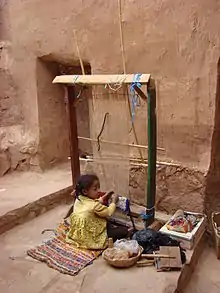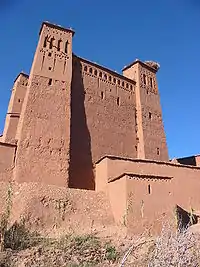Aït Benhaddou
Aït Benhaddou (Berber languages: ⴰⵢⵜ ⴱⴻⵏⵃⴰⴷⴷⵓ; Arabic: آيت بن حدّو) is a historic ighrem or ksar (fortified village) along the former caravan route between the Sahara and Marrakech in present-day Morocco. It is considered a great example of Moroccan earthen clay architecture and has been a UNESCO World Heritage Site since 1987.[1]
| UNESCO World Heritage Site | |
|---|---|
 Aït Benhaddou | |
| Official name | Ksar of Ait-Ben-Haddou |
| Location | Morocco |
| Criteria | Cultural: (iv), (v) |
| Reference | 444 |
| Inscription | 1987 (11th session) |
| Area | 3.03 ha (0.0117 sq mi) |
| Buffer zone | 16.32 ha (0.0630 sq mi) |
| Coordinates | 31°2′50″N 7°7′44″W |
 Location of Aït Benhaddou in Morocco | |
History
.jpg.webp)
The site of the ksar has been fortified since the 11th century during the Almoravid period.[2][3] None of the current buildings are believed to date from before the 17th century, but they were likely built with the same construction methods and designs as had been used for centuries before.[1] The site's strategic importance was due to its location in the Ounila Valley along one of the main trans-Saharan trade routes.[1] The Tizi n'Tichka pass, which was reached via this route, was one of the few routes across the Atlas Mountains, crossing between Marrakech and the Dra'a Valley on the edge of the Sahara.[3][1] Other kasbahs and ksour were located all along this route, such as the nearby Tamdaght to the north.[2]
Today, the ksar itself is only sparsely inhabited by several families.[3] The depopulation over time is a result of the valley's loss of strategic importance in the 20th century. Most local inhabitants now live in modern dwellings in the village on the other side of the river, and make a living off agriculture and especially off the tourist trade.[3][4]
Description
.jpg.webp)
.jpg.webp)
Layout of the site
The ksar is located on the slopes of a hill next to the Ounila River (Asif Ounila). The village's buildings are grouped together within a defensive wall that includes corner towers and a gate.[1] They include dwellings of various size ranging from modest houses to tall structures with towers. Some of the buildings are decorated in their upper parts with geometric motifs. The village also has a number of public or community buildings such as a mosque, a caravanserai, a kasbah (castle-like fortification) and the Marabout of Sidi Ali or Amer. At the top of the hill, overlooking the ksar, are the remains of a large fortified granary (agadir).[3] There is also a public square, a Muslim cemetery, and a Jewish cemetery.[1] Outside the ksar's walls was an area where grain was grown and threshed.[1]
Building materials
The ksar's structures are made entirely out of rammed earth, clay bricks, and wood.[1] Rammed earth (also known as pisé, tabia, or al-luh) was a highly practical and cost-effective material but required consistent maintenance.[5][6] It was made of compressed earth and mud, usually mixed with other materials to aid adhesion. The structures of Ait Benhaddou and of other kasbahs and ksour throughout this region of Morocco typically employed a mixture of earth and straw, which was relatively permeable and easily eroded by rain over time.[5] As a result, villages of this type can begin to crumble only a few decades after being abandoned.[7][4]
Preservation
The ksar has been significantly restored in modern times, thanks in part to its use as a Hollywood filming location and to its inscription on the UNESCO list of World Heritage Sites in 1987.[1][2] UNESCO reports that the ksar has "preserved its architectural authenticity with regard to configuration and materials"[1] by continuing to use traditional construction materials and techniques and by largely avoiding new concrete constructions. A local committee is in charge of monitoring and managing the site.[1]
Films shot at Aït Benhaddou

A large number of films shot in Morocco have used Aït Benhaddou as a location, including:[8][9][10][4]
- Sodom and Gomorrah (1963)
- Oedipus Rex (1967)
- The Man Who Would Be King (film) (1975)
- The Message (1976)
- Jesus of Nazareth (1977)
- Time Bandits (1981)
- Marco Polo (1982)
- The Jewel of the Nile (1985)
- The Living Daylights (1987)
- The Last Temptation of Christ (1988)
- The Sheltering Sky (1990)
- Kundun (1997)
- The Mummy (1999)
- Gladiator (2000) [11]
- Alexander (2004)
- Kingdom of Heaven (2005)
- Babel (2006)
- One Night with the King (2006)
- Prince of Persia (2010)
- Son of God (film) (2014)
- Queen of the Desert (film) (2015)
- David Attenborough: A life on our planet (2020)
Also used in parts of the TV series Game of Thrones[12] and the Brazilian TV series O Clone.
Gallery
 Overall view of Ksar Ait Benhaddou (from across the valley).
Overall view of Ksar Ait Benhaddou (from across the valley)..jpg.webp) View of the Asif Ounila (Ounila River) next to the village.
View of the Asif Ounila (Ounila River) next to the village..jpg.webp) A recently-constructed bridge across the river.
A recently-constructed bridge across the river..jpg.webp) Townscape of Ait Benhaddou, seen from the river.
Townscape of Ait Benhaddou, seen from the river..jpg.webp) Entrance to the ksar today.
Entrance to the ksar today. A kasbah (fortified structure) in the lower part of the village.
A kasbah (fortified structure) in the lower part of the village. View of the top level of the kasbah.
View of the top level of the kasbah..jpg.webp) A typical street inside the ksar.
A typical street inside the ksar..jpg.webp) A traditional wooden door in one of the buildings.
A traditional wooden door in one of the buildings..jpg.webp)
.jpg.webp) Kasbah Tamdaght, an unrestored kasbah a few kilometres north of Ait Benhaddou.
Kasbah Tamdaght, an unrestored kasbah a few kilometres north of Ait Benhaddou.
See also
References
| Wikimedia Commons has media related to Aït Benhaddou. |
| Wikivoyage has a travel guide for Aït Benhaddou. |
- "Ksar of Ait-Ben-Haddou". whc.unesco.org. UNESCO World Heritage Centre. Retrieved 2018-02-16.
- "Ait Ben Haddou travel". Lonely Planet. Retrieved 2020-04-16.
- "Rough Guides - Aït Benhaddou and around". Rough Guides. Retrieved 2020-04-16.
- Jacobs, Harrison. "One of the most famous places in the world is a tiny desert town in Morocco where everything from 'Game of Thrones' to 'Gladiator' was filmed". Business Insider. Retrieved 2020-04-16.
- Parker, Richard (1981). A practical guide to Islamic Monuments in Morocco. Charlottesville, VA: The Baraka Press. p. 40.
- Futura. "Pisé". Futura (in French). Retrieved 2020-01-08.
- The Rough Guide to Morocco (11 ed.). London: Rough Guides. 2016. p. 390. ISBN 9780241236680.
- "Filming Location Matching "Ait Benhaddou, Morocco" (Sorted by Release Date Ascending)". IMDb. Retrieved 2020-04-16.
- "Movies Filmed at Ait Benhaddou in Morocco - Mosaic North Africa". Mosaic North Africa Tours - Morocco, Algeria and Tunisia Tours. 2017-01-06. Retrieved 2020-04-16.
- Jon Jensen; Alex Court. "Moroccan backdrop for Game of Thrones and Gladiator". CNN. Retrieved 2020-04-16.
- "Ksar Ait Benhaddou | History and Travel Guide - Moroccan Zest". Moroccan Zest. 2018-09-28. Retrieved 2018-09-28.
- Jon Jensen; Alex Court. "Moroccan backdrop for Game of Thrones and Gladiator". CNN. Retrieved 2017-11-23.
